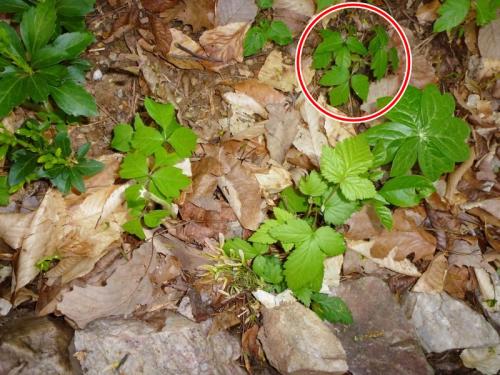How to Identify Poison Ivy From the Fakes
How to identify poison ivy from the fakes.
Well, it's summer and that means, please sing along, 'tis the season, for poison ivy. People often take walks in the woods in summer. So, look out!
Poison ivy is the bane of every Boy Scoutmaster and scout camp in history! It's also the bane of hikers who cannot identify it from the other plants that might look like it.
It's easily identified. Just three equal, shiny leaves. Then there are the sayings, "Leaves of three, leave it be..."
Well, not so fast! There are a lot of shiny, and many three-leaf, plants out there that are not poison ivy.
So, which is the poison ivy? Look at the photo.

Hint: The upper left? Nope. The upper left is pachysandra, a very aggressive ground cover in shady areas.
Hint: The right center? Nope. The round plant on the right is a May Apple. It produces little, edible apples in, um, wait, it's coming to me, oh! In May. (Scoutmaster hint: wait until they are really ripe or they are bitter. Even ripe a little sugar helps.)
Hint: the lower right center? Nope. That's wild raspberry. It will grow fast, tall and have very sharp thorns on it.
Hint: the left center? Nope. That is a wild, shady creeper. Scouts mistake it all the time for poison ivy.
Fact: the upper right center! I put a very thin red circle around it in case you missed it! Poison oak looks very similar, and shiny, but has rougher-looking leaves.
Poison ivy truly has three equal leaves, but they are a deeper green and shiny.
The shininess comes from an oil in the leaf, called URUSHIOL OIL. That oil classifies poison ivy as a TOXICODENDRON.
It is a true ivy, with rhizomes that shoot out underground, springs up into what looks like a single plant nearby. When it climbs trees it has the big, hairy root. It is parasitical, feeding off the host tree or shrub.
If you brush up against it, and the oil has enough time to bond, and a few hours is all it takes, you can get it. Some people are immune and do not get the skin rash, but that is only about 20% of us.
What do you do if you think you may have come in contact with poison ivy? Wash as soon as possible with COLD WATER and dishwasher soap. That soap is formulated to remove grease and oils. DO NOT use hot water, which opens the skin pores.
What do you do if you get the poison ivy rash? Over the counter treatments will not shorten the itching time! You will be affected for about two weeks! All the over-the-counter poison ivy creams and lotions are basically useless. Calamine lotion makes things feel better because it contains alcohol which makes the affected area feel cool for a while, but it can crack your skin. Hydro-cortisone creams might feel better for a while too, because they shrink the rash blisters. BUT YOU WILL STILL HAVE THE RASH FOR ABOUT TWO WEEKS.
The doctor might prescribe a steroid, or give you a shot. But it likely won't shorten the itchy time either.
Iffn' yew wont sum genrul buuk lernin', click here. (That is true Southern Virginian dialect and authentic)
My recommendation: when you see poison ivy in its very young state, get rid of it. But pulling it might not help because of its rhizome shoots. Spray it with an herbicide and it will not come back. And good luck! No touchy.

Comments
Post new comment